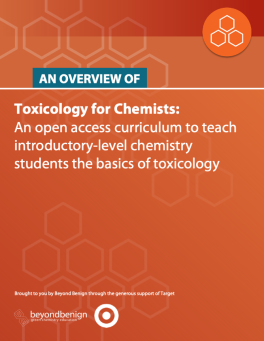10 - Predictive Toxicology (Toxicology for Chemists - Module 10)

Summary
This module provides an overview of computational methods to predict the toxicity of chemicals. Students will learn an updated overview of the latest methods that have been successfully applied to predict toxic effects of chemicals, in addition to understanding the outlook towards at the nexus of computational sciences and toxicology. Particular emphasis is placed on carbon-based toxicants. Multiple case studies and in-class discussions and assignments are provided in the lecture slides in addition to an extensive set of homework activities for students to do outside of the classroom. You will additionally gain access to multiple GAMESS activities and problem sets.
What’s included?
Lectures:
“10A – Computational Chemistry in Toxicology” (2-3 hours)
“10B – Developing Descriptors by Model Size and Detail Level”
Lesson Plans:
For all lectures
Supplementary Information:
GAMESS tutorials
Four homework assignments
Installation files
Past problem sets
Supplementary Videos: Recordings of these lectures being used in class. Coming soon!
File Size: 881 MB – this file is very large, please ensure you have good internet connectivity and time for the download to occur before downloading.
This course module was authored by:
Dr. Jakub Kostal, Assistant Professor, The George Washington University
Charlotte Snyder, Environmental Protection Specialist, US Environmental Protection Agency
The content of this module was reviewed by:
Dr. Cintia Milagre, Assistant Professor, Institute of Chemistry at UNESP – Brazil
Dr. Sam Krerowicz, Lecturer of Chemistry, Indiana University East
What’s included?
Lectures:
“10A – Computational Chemistry in Toxicology” (2-3 hours)
“10B – Developing Descriptors by Model Size and Detail Level”
Lesson Plans:
For all lectures
Supplementary Information:
GAMESS tutorials
Four homework assignments
Installation files
Past problem sets
Supplementary Videos: Recordings of these lectures being used in class. Coming soon!
File Size: 881 MB – this file is very large, please ensure you have good internet connectivity and time for the download to occur before downloading.
This course module was authored by:
Dr. Jakub Kostal, Assistant Professor, The George Washington University
Charlotte Snyder, Environmental Protection Specialist, US Environmental Protection Agency
The content of this module was reviewed by:
Dr. Cintia Milagre, Assistant Professor, Institute of Chemistry at UNESP – Brazil
Dr. Sam Krerowicz, Lecturer of Chemistry, Indiana University East
Safety Precautions, Hazards, and Risk Assessment
N/A
Digital Object Identifier (DOI)
https://doi.org/10.59877/LIIV1714
File (PDF, PPT, image, etc)
File (PDF, PPT, image, etc)
Creative Commons License

This work is licensed under a Creative Commons Attribution-NonCommercial-ShareAlike 4.0 International License.

